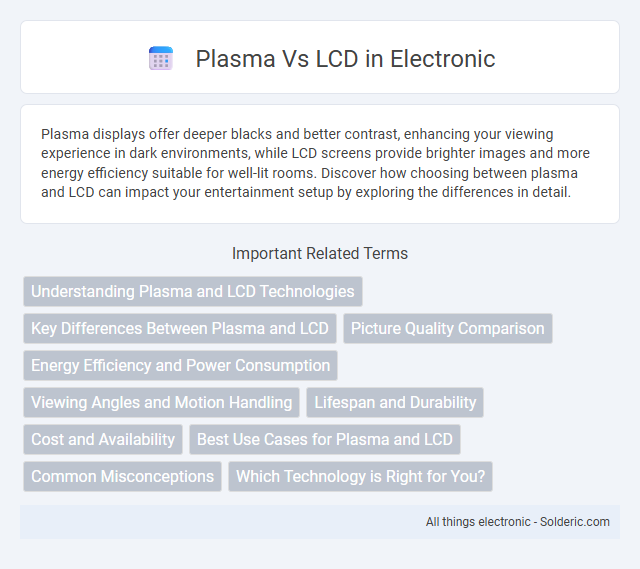Plasma displays offer deeper blacks and better contrast, enhancing your viewing experience in dark environments, while LCD screens provide brighter images and more energy efficiency suitable for well-lit rooms. Discover how choosing between plasma and LCD can impact your entertainment setup by exploring the differences in detail.
Comparison Table
| Feature | Plasma | LCD |
|---|---|---|
| Display Technology | Gas plasma cells emitting light | Liquid crystals with backlight |
| Image Quality | Better contrast and deeper blacks | Brighter screens with sharper images |
| Viewing Angles | Wide viewing angles with minimal distortion | Narrower viewing angles; color shift possible |
| Energy Consumption | Higher power usage | More energy-efficient |
| Screen Size | Ideal for large screens (40"+) | Common in small to medium sizes |
| Burn-in Risk | Higher risk of image retention | Minimal to no burn-in |
| Weight | Generally heavier | Lighter and thinner designs |
| Response Time | Fast response, good for motion | Slower response, may cause motion blur |
| Price | Typically more expensive for larger sizes | More affordable and widely available |
Understanding Plasma and LCD Technologies
Plasma displays use small cells containing electrically charged ionized gases or plasma to produce images, offering deep blacks and high contrast ratios ideal for dark room viewing. LCD screens rely on liquid crystals manipulated by backlight to control light passage, providing energy efficiency and sharper resolution under bright lighting conditions. Understanding these fundamental differences highlights plasma's strength in color accuracy and motion handling versus LCD's advantage in brightness and lifespan.
Key Differences Between Plasma and LCD
Plasma displays offer superior color accuracy and deeper blacks compared to LCDs, enhancing picture quality in dark scenes. LCD panels generally provide higher brightness levels and better energy efficiency, making them suitable for well-lit environments. Additionally, plasma screens typically have wider viewing angles and faster response times, reducing motion blur in fast-paced content.
Picture Quality Comparison
Plasma displays offer deeper blacks and higher contrast ratios due to their ability to individually illuminate pixels, resulting in more vibrant and true-to-life colors compared to LCD screens. LCDs rely on backlighting, which can cause light bleed and less uniformity in dark scenes, often leading to washed-out images and lower contrast. For fast-moving images, plasma panels generally provide smoother motion handling and reduced blur, enhancing the overall picture quality for video content.
Energy Efficiency and Power Consumption
Plasma TVs generally consume more power than LCD TVs due to their continuous illumination of each pixel, resulting in higher energy usage especially during bright scenes. LCD screens use LED backlighting which is more energy-efficient, making them ideal for reducing your electricity bills while maintaining good image quality. Choosing an LCD can significantly lower your power consumption without compromising on visual performance.
Viewing Angles and Motion Handling
Plasma displays generally offer superior viewing angles compared to LCDs, maintaining consistent color and brightness even at wide angles up to 170 degrees. In terms of motion handling, plasma screens excel with faster response times and minimal motion blur, making them ideal for fast-paced content like sports or action movies. LCDs often struggle with slower pixel response, resulting in ghosting effects and reduced clarity during rapid motion sequences.
Lifespan and Durability
Plasma TVs typically offer a lifespan of around 30,000 to 60,000 hours, while LCD screens can last longer, often exceeding 60,000 hours due to less susceptibility to burn-in and pixel degradation. Plasma displays are more vulnerable to screen burn-in, which affects durability over time, especially with static images, whereas LCDs are more resistant to this issue. Your choice should consider usage patterns to maximize longevity, with LCDs being a more durable option for prolonged and varied viewing.
Cost and Availability
Plasma TVs generally have higher production costs, making them more expensive compared to LCD models, which benefit from widespread manufacturing and economies of scale. LCD TVs dominate the market, offering greater availability across various price points and screen sizes. As a result, consumers often find a broader selection and more competitive pricing when choosing LCD over plasma displays.
Best Use Cases for Plasma and LCD
Plasma displays excel in dark room environments where deep blacks and high contrast ratios enhance movie watching and gaming experiences, making them ideal for home theaters. LCD screens perform best in bright, well-lit spaces such as offices or living rooms due to their higher brightness levels and reduced glare. Your choice between plasma and LCD should consider ambient lighting and viewing content to maximize visual quality.
Common Misconceptions
Plasma displays are often mistaken for having inferior image quality compared to LCDs, but they excel in producing deeper blacks and better contrast ratios, particularly in dark viewing environments. Common misconceptions also include the belief that plasma screens consume more power and suffer from screen burn-in, whereas modern plasma technology has significantly minimized these issues through advanced pixel-refreshing techniques. LCD panels are frequently assumed to have faster response times, yet high-quality plasma displays can achieve comparable performance, especially in fast-moving scenes.
Which Technology is Right for You?
Plasma displays offer superior color accuracy and deeper blacks, making them ideal for dark-room viewing and movie enthusiasts. LCD screens are more energy-efficient, lightweight, and perform better in bright environments, which suits everyday use and gaming. Your choice depends on whether you prioritize rich contrast and cinematic experience or practical brightness and energy savings.
Plasma vs LCD Infographic

 solderic.com
solderic.com